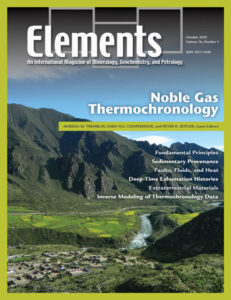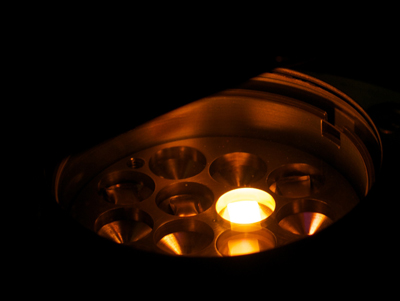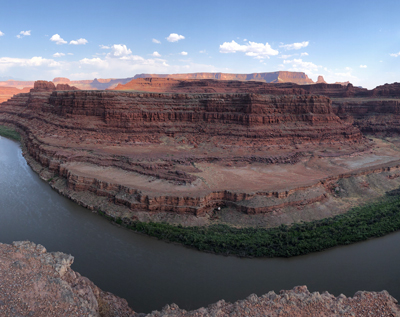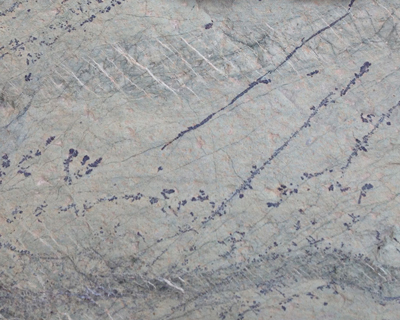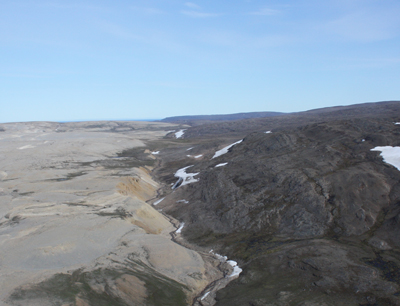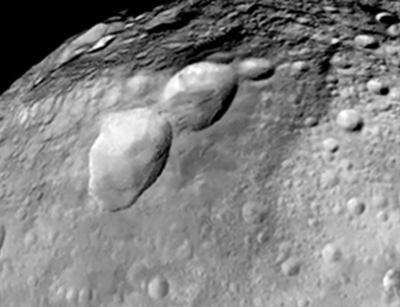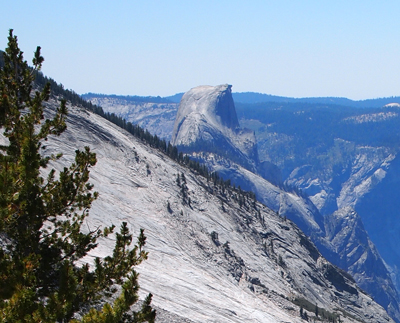Noble Gas Thermochronology
Marissa M. Tremblay, Emily H.G. Cooperdock, and Peter K. Zeitler – Guest Editors
Table of Contents
Noble-gas thermochronology takes advantage of two properties: (1) the time-dependent production of noble gases, such as helium and argon, by processes like radioactive decay; (2) the thermally activated diffusion of these gases to constrain the temperature histories of several minerals commonly found in crustal rocks. Because temperature is essential to many geological processes, thermochronology has become widely used to address research questions across Earth and planetary science. These questions include when and how valleys are cut by glaciers; from where is sediment sourced; what thermal conditions occur on fault planes during slip; and how the surfaces of planetary bodies evolve on billion-year timescales. This issue will highlight how noble-gas thermochronology can be used to address questions like these, as well as what new avenues of research noble-gas thermochronology could be used for in the future.
- Noble Gases Deliver Cool Dates from Hot Rocks
- Earth’s Dynamic Past Revealed by Detrital Thermochronometry
- Iron Oxide (U–Th)/He Thermochronology: New Perspectives on Faults, Fluids, and Heat
- Vestiges of the Ancient: Deep-Time Noble Gas Thermochronology
- Noble Gas Thermochronology of Extraterrestrial Materials
- Lazed and Diffused: Untangling Noble Gas Thermochronometry Data for Exhumation Rates
Bruker AXS
Crystal Maker
Excalibur Mineral Corporation
Gemological Institute of America
Geological Society of London
International Centre for Diffraction Data
International Association of Geoanalysts
Materials Research Society
ProtoXRD
Savillex
University of St. Andrews
v16n6 Hydrothermal Fluids
GUEST EDITORS: Matthew Steele-MacInnis (University of Alberta, Canada) and Craig E. Manning (University of California, Los Angeles, USA)
Fluids are the principle agents of heat and mass transfer in the Earth. This thematic issue will explore the physical and chemical properties of hydrothermal fluids and how they affect geologic processes. The issue will discuss our current understanding of the nature of hydrothermal fluids across a range of geologic settings; interactions between fluids and rocks; and the interrelationships between fluid-driven processes in different settings. Each article will highlight both broad and specific overlaps between “normal” and ore-forming hydrothermal fluids and will describe how the features of hydrothermal systems reflect the specific properties of the fluids in each setting.
- Hydrothermal Properties of Geologic Fluids Matthew Steele-MacInnis (University of Alberta, Canada) and Craig E. Manning (University of California, Los Angeles, USA)
- Crustal Metamorphic Fluids Katy A. Evans (Curtin University, Australia) and Andrew G. Tomkins (Monash University, Australia)
- Fluids in Submarine Hydrothermal Settings Esther M. Schwarzenbach (Freie Universität Berlin, Germany) and Matthew Steele-MacInnis (University of Alberta, Canada)
- Fluids in Subduction Zones and the Upper Mantle Craig E. Manning (University of California, Los Angeles, USA) and Maria-Luce Frezzotti (Università degli Studi di Milano, Italy)
- Magmatic–Hydrothermal Fluids Andreas Audétat (Universität Bayreuth, Germany) and Marie Edmonds (University of Cambridge, UK)
- Geothermal Fluids Isabelle Chambefort (GNS Science, New Zealand) and Andri Stefansson (University of Iceland, Iceland)
- Abiotic Hydrogen and Hydrocarbons in Planetary Lithospheres (February 2020)
- Raman Spectroscopy in the Earth and Planetary Sciences (April 2020)
- The Redox Engine of Earth (June 2020)
- Lithium: Less is More (August 2020)
- Noble Gas Thermochronology (October 2020)
- Hydrothermal Fluids (December 2020)



